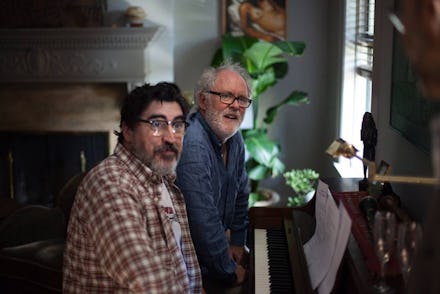The MPAA Has Some Explaining to Do for This Movie's R-Rating

Movie ratings are often ridiculous, but this year the MPAA might have gone too far. Love Is Strange, a quiet story about an elderly gay couple who face homelessness, received an R rating. Understandable, if clothed cuddling, conversations between family members and Cheyenne Jackson count as controversial movie content.
The sad reality is that the rating reeks of a reluctance to consider homosexuality as an uncontroversial, everyday fact.
In Love Is Strange, nobody is naked and nobody has sex on camera. There is no blood or physical violence. There is swearing, yes; maybe half a dozen instances and nothing particularly strong. The great-nephew of John Lithgow's character tells him to "fuck off," and other curses are interspersed in the dialogue once or twice. That's it. In comparison, the weekend's other movie that drew an R rating was Sin City 2: A Dame to Kill For — a film filled with bloodlust, nudity and shlocky misogyny. The real question: How are both of these films rated R?
The official answer to that question can be found on the MPAA website, which classifies an R-rated film as one that:
Contains some adult material. Parents are urged to learn more about the film before taking their young children with them.
Note that the action movie The Expendables 3, bloody and destructive as it is, only warranted a PG-13 rating. The Hunger Games, full of bloody child-on-child murders, is a PG-13. Christopher Nolan's Dark Knight trilogy, full of dour cityscapes, rampant crime and psychopathic terrorists, was also only a PG-13. Apparently rampant violence is not enough for parental accompaniment. One has to wonder if the MPAA found something other than a rogue F-word objectionable for young people about Love Is Strange. The quick answer, and the conclusion to which many people are jumping, is the presence of homosexual couples as main characters.
Many other movies that have featured gay couples have also been rated R. The Kids Are All Right, a pretty tame, charming movie with one sex scene, was rated R. The Birdcage, starring Nathan Lane and Robin Williams as an older gay couple, was also rated R. Velvet Goldmine, My Beautiful Laundrette, Brokeback Mountain, My Summer Of Love and Milk, all movies with gay relationships, also all received R ratings. While some of them may have deserved the rating for other content, there seems to be a consistent theme across gay-centric movies the MPAA rates. Something about them seems to merit an R rating, which usually accompanies far more violent, racy pictures than Love Is Strange.
J. Bryan Lowder points out in a recent Slate piece that Love Is Strange shows a beautiful, happy marriage and a hopeful future for young gay men: "It offers a vision of a gay romantic future that, while beset with a specific struggle, is also full of love, as well as a sense of community and history — older, happy gay people exist! [...]for the straight kids, the film can reinforce the dignity of gays and their relationships in a way that abstract lectures never could."
The Wrap compared this outrage to previous examples of nervous ratings for gay movies. Last year director Darren Stein posted to Facebook that his gay-centric movie G.B.F. had received an R rating which he couldn't understand: "Perhaps the ratings box should more accurately read 'For Homosexual References' or 'Too Many Scenes of Gay Teens Kissing.' I look forward to a world where queer teens can express their humor and desire in a sweet, fun teen film that doesn't get tagged with a cautionary R."
“Love Is Strange” Rated R for language. #LoveIsStrange
A spokesman for the MPAA asserted that profane language was the sole reason for the R rating. But according to a Huffington Post piece on the proliferation of F-bombs in modern cinema, usages of the word that are contextually appropriate or inconspicuous are allowed under MPAA rulings. Having seen the film, I can barely remember where the profanity was anything more than that.
Great examples of LGBT characters in family-friendly projects have already made their way onto screens: Mitch in ParaNorman, who admits to having a boyfriend; the gay parents who appeared on Disney TV show Good Luck Charlie; the married lesbian couple Madame Vastra and Jenny in Doctor Who. Shows like Girls and Looking on HBO also provide teen audiences with gay male characters who show how multifaceted and varied gay men can be. But there is always more to be done, and a rating like this is a step backwards.
By including LGBT characters in the wider media landscape of the world, children and teenagers are exposed to a version of the world that contains a wide variety of sexual orientations. There's no reason for parental accompaniment to a quiet film about an older couple.